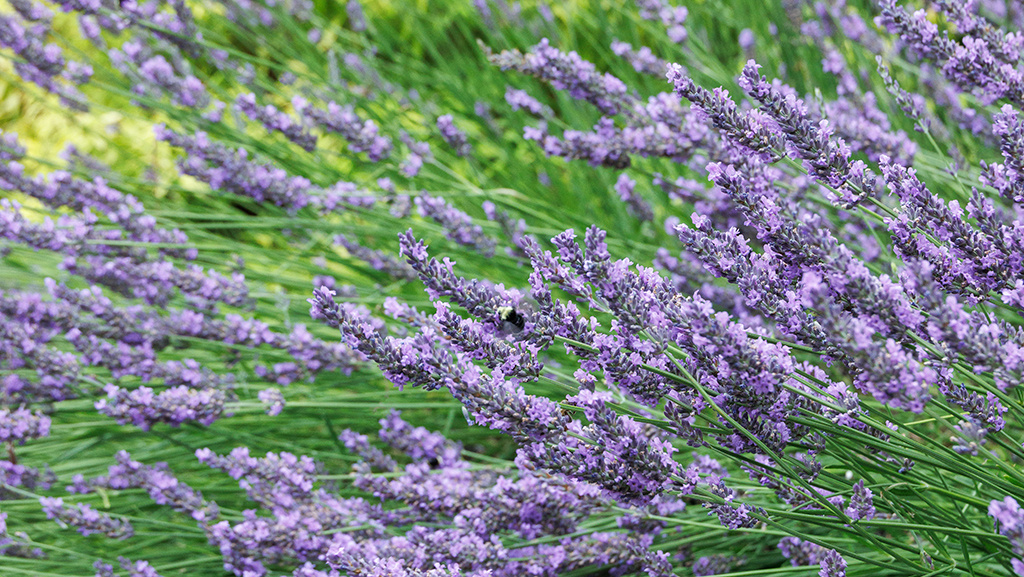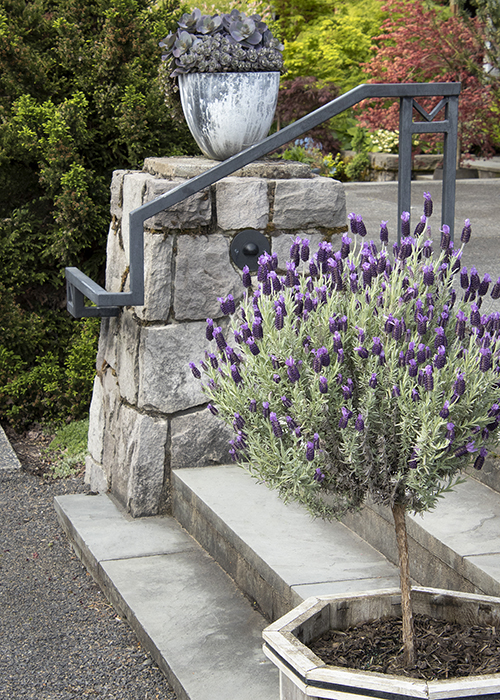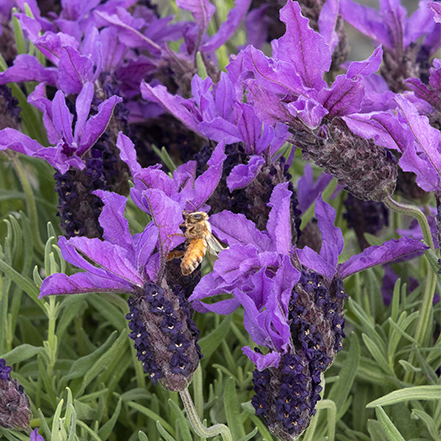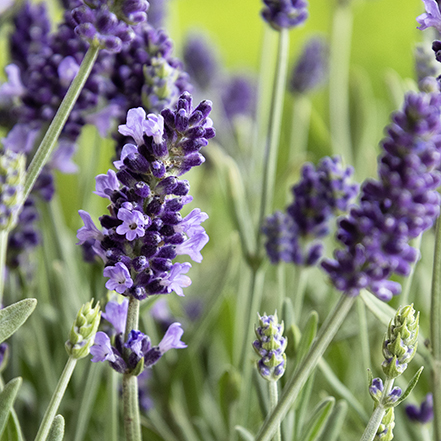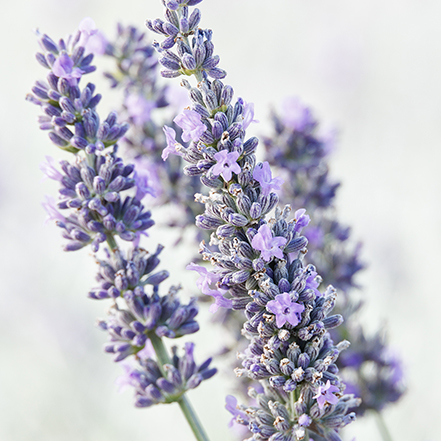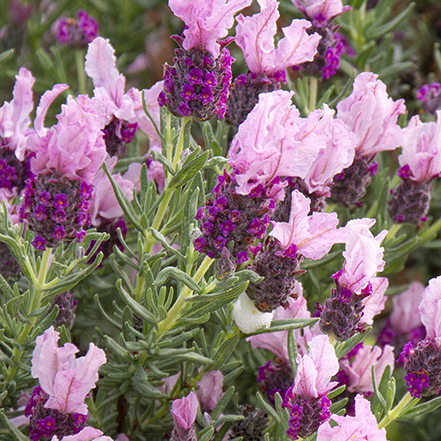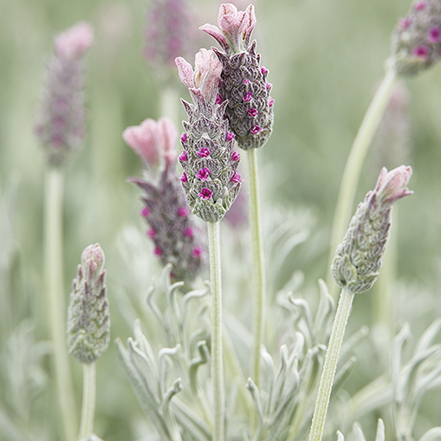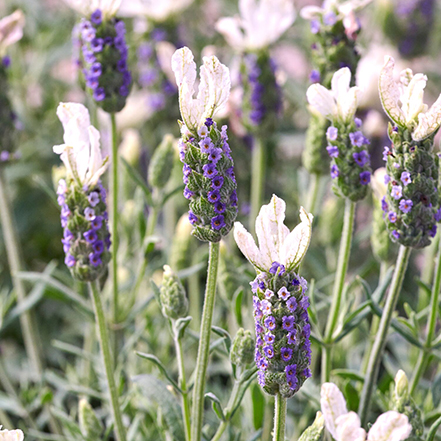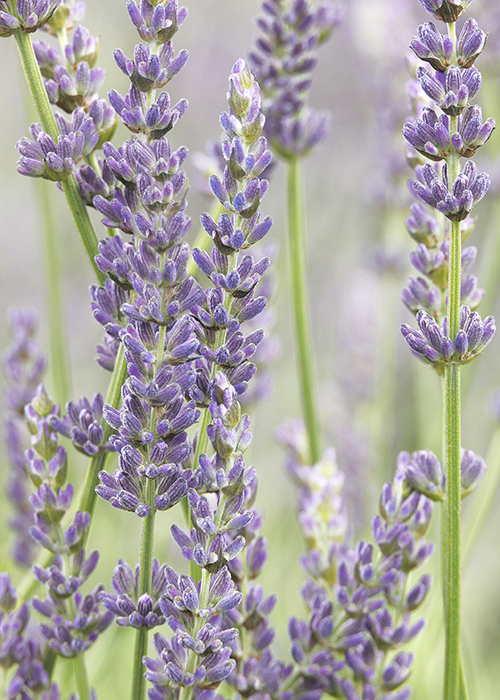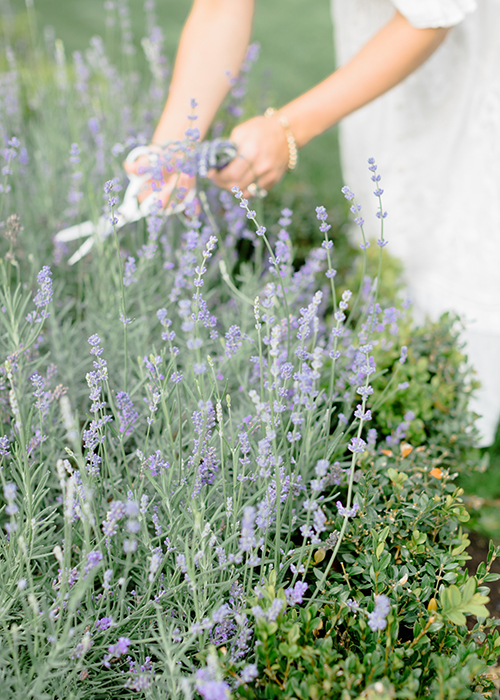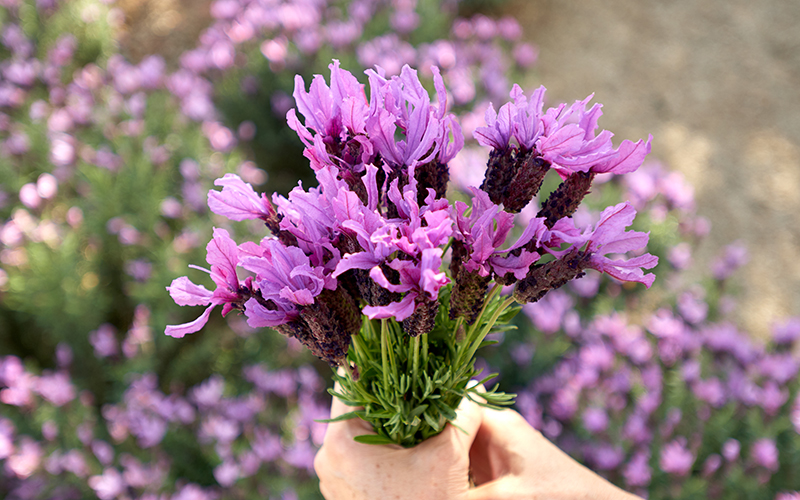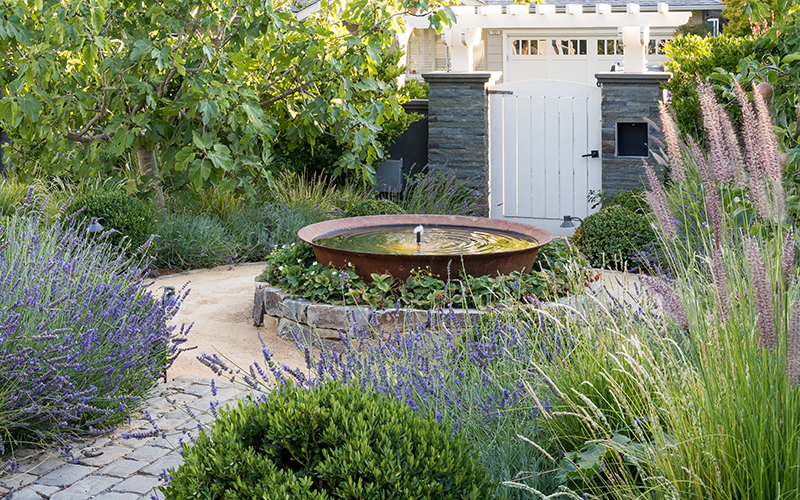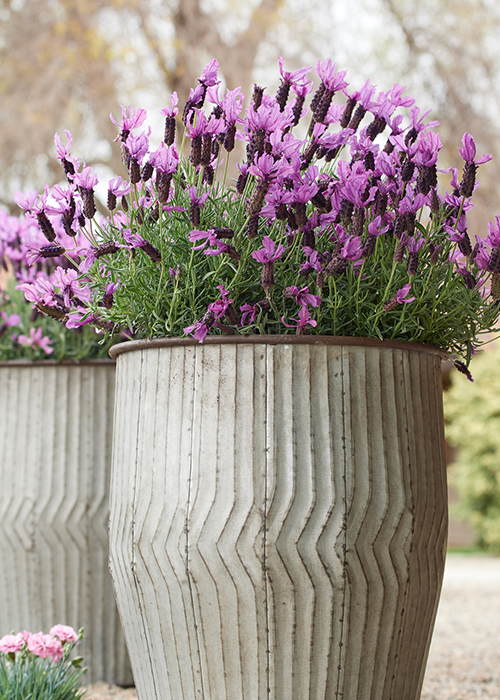Lavender, known for its delicate fragrance and evergreen grayish-green foliage, oscillates effortlessly between being an herb, a medicinal plant, and an ornamental, pollinator-friendly shrub. It has a long bloom season and, thanks to its upright flower spikes and mounded shrub form, can be used to create informal hedges, serve as an accent plant, or add aromatic beauty to patio containers.
From understanding the various types of lavender plants (Monrovia grows over 33 varieties) to meeting their care requirements, we cover it all in this guide.
What Is Lavender?
(Above) Anouk Spanish Lavender in patio tree form.
Lavender is a genus (Lavandula) of roughly 47 known species of flowering plants in the mint family, Lamiaceae. Most species are native to the "Old World," growing wild in the Mediterranean region, eastern Africa, the Canary Islands, southern Asia, and India.
Recognized by its upright purple flowers, lavender is world-renowned for its distinctive and calming scent. It’s a great plant for garden design thanks to its potential to be used in various areas of the garden bed, such as borders and rock gardens. Beyond its aesthetic qualities, lavender has a range of health benefits and uses, both culinary and therapeutic. It's also adored for its resilience since it can grow well in a variety of climates with minimal care.
Types of Lavender Plants
Lavender is a diverse family with a collection of different species, each with its unique features and care requirements. Understanding these differences helps you choose the best lavender for your garden.
Variety matters when it comes to finding success with lavender in your garden. That's why Monrovia is very choosy with the types of varieties we grow. When you start with the best variety for your garden, you're much more likely to grow them confidently year after year.
Let's dive in.
English Lavender
English lavender (known botanically as Lavandula angustifolia) is one of the most cold-hardy varieties. Although native to the Mediterranean, English lavender got its name because it grows well in the cooler climate of England and is popular in English herb gardens.
This lavender type often has gray-green foliage and whorls of small flowers that range from blue-purple to vivid violet. It grows 2-3 feet tall and performs well in well-draining soil, including sandy soil; English lavender grows in zones 5-10 on the USDA hardiness scale. If you're looking for informal edging along a walkway or want to do a colorful mass planting that's easy to care for, English lavender is a great choice.
Hybrid Lavender
Lavandula x intermedia (sometimes called Lavandula hybrida) is a hybrid lavender type that's a cross between English lavender and Portuguese lavender. This hybrid combines the cold hardiness of English lavender with the heat tolerance of the Portuguese variety to give gardeners a versatile option.
Hybrid lavender produces long spikes of highly fragrant flowers that range from dark violet to white, and its gray-green foliage also carries an aroma. This popular variety can grow in zones 5-11 and works great as an accent plant or as part of an herb or rock garden.
Non-English Lavender
French or Fringed Lavender
French lavender (Lavandula dentata) is native to the Mediterranean basin, North Africa, and the Arabian peninsula. It's known for its toothed leaves that have a lavender-rosemary scent. This showy variety is recognizable for its compact flower heads with purple bracts on top. With enough sun and warmth, French lavender can bloom from early summer to fall.
Although its lavender scent is less powerful than other varieties, many gardeners prefer the rosemary aroma that comes from its fleshly crushed leaves.
Spanish Lavender
Spanish lavender, or Lavandula stoechas, is known for its distinctive flowers that have "ears" that pop up from each flower spike. Spanish lavender blooms almost constantly from mid-spring to late summer in colors that include white, pink, and purple. Although its flowers aren't very fragrant, its silvery foliage is. This variety is best for warm climates and grows in hardiness zones 7-9.
Woolly Lavender
Woolly lavender (Lavandula lanata) is a drought-tolerant, bushy shrub native to the Mediterranean basin. Characterized by soft silver-white woolly leaves accented by long stalks with purple flowers, this variety works well in rock or gravel gardens. The leaves of Woolly lavender are aromatic and very hairy, which makes them appear white. With tall, erect stems and showy flowers, this variety is great for gardeners looking to attract more bees and butterflies and enhance the biodiversity of their space.
Top-Performing Lavender Types
Below are a few of the most popular top-performing examples of each lavender type most commonly found in local garden centers.
Spanish:
Javelin Forte™ Deep
Purple Spanish Lavender
An early flowering Spanish variety adorned with an abundance of larger purple summer flowers complemented by deep purple bracts. The robust, rounded, mounding habit, is accompanied by fragrant gray-green foliage. Notably, this variety excels in enduring cold, wet winter conditions better than most. Full sun. Up to 20" tall, 18" wide. Zones 7-9.
English:
Aromatico™ Blue
Imp. Lavender
An English Lavender with major flower power. Early-blooming, deep eggplant-purple flowers stand out against the silvery-green foliage. This versatile and low-maintenance evergreen shrub is perfect for containers, low borders, and rock gardens. Full sun. Up to 20" tall, 12" wide. Zones 5-9.
Hybrid:
Riverina Thomas
Lavender
A hybrid triploid lavender variety boasting large flowers that produce five times the aromatic oil compared to its parent types. Highly prized for commercial applications, this midsummer repeat bloomer stands out as a robust garden performer, making it an excellent choice for borders or herb gardens. Up to 3' tall and wide. Zones 5-9.
Unusual Lavender Varieties
Think all lavender looks the same? Think again! Below are some of our favorite unique lavender varieties, with unexpected flower and foliage colors.
Javelin Forte™ Deep
Rose Spanish Lavender
A choice new early flowering variety with a profusion of larger purple summer flowers with deep rose-colored bracts, and a robust, rounded, mounding habit of fragrant, gray-green foliage. Great carefree, heat and drought tolerant color. Full sun. Up to 20" tall, 18" wide. Zones 7-9.
Ghostly Princess
Spanish Lavender
A neat, compact, aromatic mound of finely textured, luminous silver foliage topped by a lovely crown of shimmering lavender-pink flower spikes. A durable, yet charming, early blooming lavender that will enliven landscape or container. Full sun. Up to 30" tall and wide. Zones 8-10.
Javelin Forte™ White
Spanish Lavender
Unique blooms have green-veined white bracts above tiny light-lilac flowers. Has a robust, rounded, mounding habit of fragrant, gray-green foliage. A wonderful heat and drought-tolerant plant that tolerates cold, wet winter conditions better than most. Full sun. Up to 20" tall, 18" wide. Zones 7-9.
How to Plant and Grow Lavender
Lavender is beloved because it's easy to plant and grow. Whether you want your lavender plant to accent your rock garden or become a staple in your herb collection, here's what you need to know.
When Is the Best Time to Plant Lavender?
Generally, the best time to plant lavender is early to late spring, once the threat of frost has passed. Planting your lavender around this time helps its successful growth as temperatures warm up and give it plenty of sunlight.
Lavender can also be planted in the fall, but only larger, more established plants, like Monrovia-grown lavenders, can survive through the winter (remember to look for the green Monrovia pot at your local garden center).
Where Is the Best Place to Plant Lavender?
- Lavender plants thrive in areas with good air circulation and excellent drainage. So, if there is a possibility of standing water or wet areas around your lavender, consider a raised bed (or planting on a slope). This way, water won't sit around their roots and cause root rot.
- Lavender also loves the sun, so make sure wherever you plant it gets 6-8 hours of full sun each day.
- Keep in mind that lavender usually reaches 1-3 feet in height and width, so if you're planting multiple, space them 2-3 feet apart.
What is the Best Climate for Lavender Plants?
Lavender is a hardy plant that prefers a Mediterranean-like climate — dry, sunny, and with good air circulation. Most lavender plants don't thrive in very humid or colder climates (although English lavender can tolerate some colder weather). Most varieties are hardy from Zones 5-9.
Planting Your Lavender
Planting lavender takes a few simple steps:
- Prepare the area by removing rocks, debris, and weeds. Till the soil to a depth of 12 inches.
- Dig a hole that's twice the size (wide and deep) as the plant's root ball. Place the plant in the hole and backfill it with soil.
- Water the soil thoroughly to remove air pockets.
- Add a layer of mulch to help ward off weeds.
Essential Care for Lavender Plants
Lavender plant care is relatively simple. Make sure you monitor soil and sunlight conditions, give your plant some water, and practice timely pruning and harvesting. For a plant that can bloom month after month and adds a sweet-smelling fragrance to your garden, the simple care is well worth it!
Ideal Soil and Sunlight Conditions
Good drainage and full sun are non-negotiables in the checklist of planting and caring for lavender. To make sure you have the best soil for your lavender plants, consider:
- Adding gravel or sand to improve drainage if needed.
- Keeping lavender plants away from the shadow of trees or buildings.
- Mulching with an inch of small stones, pea gravel or pebbles, which reflects the sun into the center of the plant and keeps the roots cool.
Watering and Fertilizing Techniques
Lavender plants are drought-tolerant and need less watering than most plants. In the first summer of your lavender plant, water it regularly to help it get established, about once a week. Once established, lavender rarely needs watering unless there's an extended period of drought.
When it comes to fertilizing, lavender plants are not heavy feeders. In fact, these plants prefer soil that's low in nutrients, so steer clear of adding fertilizers. An excess of nitrogen can actually cause your plant to produce excess foliage and fewer flowers.
Pruning Lavender Plants
Pruning lavender ensures its cropped, tiny foliage comes back year after year. But the actual pruning process depends on the type of lavender you're growing.
For example, to prune English lavender:
- Prune this plant right after its first flowering. Prune it again in late August after the last flush fades.
- Cut off about 2/3 of the plant’s height or to just above the bottom two sets of leaves on each stem.
- Don't cut into the woody part of the plant unless you are removing dead branches.
To explore the pruning process further, check out our guide on how and when to prune different types of lavender.
Pest Control and Common Lavender Plant Problems
Pests That Affect Lavender Plants
Lavender plants, with their fragrant and colorful blooms, might be the stars of your garden bed, but they can also attract some unwanted guests. Pests that commonly infest lavender plants include:
- Whiteflies: These pests suck the juice out of the lavender's foliage, causing wilting and yellowing. They can be eliminated with a strong spray of water to remove the adult insects (or larvae) followed by an insecticidal soap.
- Gray Mold: Although not an insect, this fungus acts like a pest by appealing to insects with a sweet smell. It thrives in cool, wet conditions and can be deterred by improving air circulation around your lavender plants.
- Root Weevils: Typically found in potted lavender plants, these pests feed on the plant's roots and can cause significant damage. You may need to repot the plant in fresh, sterilized soil to get rid of them.
Controlling these pests is key to making sure your lavender stays healthy and vibrant.
Prevention and Treatment of Common Lavender Diseases
Despite their rugged nature, lavender plants can succumb to a range of diseases, particularly when they're stressed or planted in unfavorable conditions. Here are some common diseases to watch out for:
- Fungal Diseases: These are spurred by excess moisture and poor air circulation and are among the most common issues that affect lavender plants. Symptoms may include leaf spotting, wilting leaves, or a powdery coating on the plant. The best way to prevent fungal disease is to plant lavender in well-drained soil and ensure that it isn't overcrowded - remember, lavender loves the sun!
- Root Rot: Often seen in over-watered plants, root rot can cause lavender plants to wilt and turn yellow. To prevent root rot, make sure your plant is housed in well-draining soil and avoid overwatering.
Putting Lavender to Use
Lavender isn't all just about the aesthetics or the delightful scent; the plant boasts an impressive list of applications that make it beloved around the world:
- Culinary Uses: Certain varieties of lavender can add an exquisite twist to dishes with its slightly sweet, floral flavor. English lavender is commonly used in cooking; its blue flowers and leaves lend unique flavor profiles to desserts, jellies, ice creams, and savory meals. The flower spikes can also be used to prepare a refreshing infusion - lavender tea.
- Aromatherapy: Lavender oil is a popular component in aromatherapy, revered for its calming properties. It's often used in bath products and diffusers to alleviate stress and induce relaxation.
- Home Decor: Just because your lavender is done blooming doesn't mean it's not useful year-round. Dried lavender bundles can serve as a rustic addition to home decor. They enhance the aesthetics and envelop the space with their pleasant and calming aroma that may remind you of the warmth of spring and summer.
- Personal Care Products: Lavender's appealing scent and alleged antiseptic properties have made it a common ingredient in skincare and hair care products. It's often found in soaps, shampoos, lotions, and perfumes.
- Pollinator Garden: Last, but not least, lavender is an exceptional addition to a butterfly garden. Its rich nectar attracts butterflies and bees, promoting pollination and adding more life to your space.
Quick Ideas for Using Lavender in Garden Design
(Above) Strawberries, lavender, boxwood, and fountain grass grow in an abundant entryway garden in this space designed by Christian Douglas. Photo by Adam Potts.
(Above) Petite Pillar Dwarf Boxwood and Javelin Forte™ Deep Purple Spanish Lavender in a narrow border.
(Above) Lavender looks fantastic in containers. Here, we have Javelin Forte™ Lavender in two containers, providing a big pop of color on the patio.
Get More Plant Care Tips and Guides
- Sign up for the Grow Beautifully Newsletter. You'll get gardening tips, design advice, free digital guides, and live webinar invites. Plus, new, exclusive plant information delivered straight to your inbox twice a month.
- Types of Lavender: How to Choose the Best Lavender for Your Garden
- How and When to Prune Different Types of Lavender
- Hibiscus Care Guide
- Conifer Care Guide
- Boxwood Winter Care
- Azalea Care Guide
- Hydrangea Care Guide
- Top 10 Tips for Planting in Summer
- How to Put Hydrangeas to Bed for Winter
- Our Top 10 Gardening Tips
- Guide to Pruning Flowering Shrubs
- How and When to Prune Hydrangeas
- Pruning Ornamental Grasses
- How and When to Prune Lavender
- Check out the "Garden Tips" section of the blog. Here there are care guides and garden tips on a wide array of plants.




